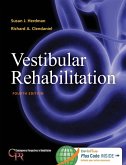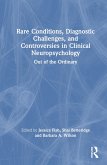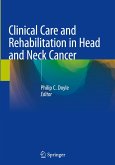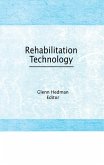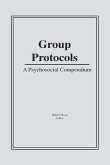- Gebundenes Buch
- Merkliste
- Auf die Merkliste
- Bewerten Bewerten
- Teilen
- Produkt teilen
- Produkterinnerung
- Produkterinnerung
A definitive textbook for students in speech-language pathology, and communication sciences and disorders, Principles and Practices in Augmentative and Alternative Communication offers an introduction to augmentative and alternative communication (AAC) and prepares them for working with clients with complex communication needs.
Andere Kunden interessierten sich auch für
![Vestibular Rehabilitation Vestibular Rehabilitation]() Susan J HerdmanVestibular Rehabilitation203,99 €
Susan J HerdmanVestibular Rehabilitation203,99 €![Incredible Consequences of Brain Injury Incredible Consequences of Brain Injury]() Alexander R ToftnessIncredible Consequences of Brain Injury174,99 €
Alexander R ToftnessIncredible Consequences of Brain Injury174,99 €![Rare Conditions, Diagnostic Challenges, and Controversies in Clinical Neuropsychology Rare Conditions, Diagnostic Challenges, and Controversies in Clinical Neuropsychology]() Rare Conditions, Diagnostic Challenges, and Controversies in Clinical Neuropsychology176,99 €
Rare Conditions, Diagnostic Challenges, and Controversies in Clinical Neuropsychology176,99 €![Clinical Care and Rehabilitation in Head and Neck Cancer Clinical Care and Rehabilitation in Head and Neck Cancer]() Clinical Care and Rehabilitation in Head and Neck Cancer132,99 €
Clinical Care and Rehabilitation in Head and Neck Cancer132,99 €![Narratives, Health, and Healing Narratives, Health, and Healing]() Narratives, Health, and Healing207,99 €
Narratives, Health, and Healing207,99 €![Rehabilitation Technology Rehabilitation Technology]() Glenn E HedmanRehabilitation Technology98,99 €
Glenn E HedmanRehabilitation Technology98,99 €![Group Protocols Group Protocols]() Diane GibsonGroup Protocols165,99 €
Diane GibsonGroup Protocols165,99 €-
-
-
A definitive textbook for students in speech-language pathology, and communication sciences and disorders, Principles and Practices in Augmentative and Alternative Communication offers an introduction to augmentative and alternative communication (AAC) and prepares them for working with clients with complex communication needs.
Hinweis: Dieser Artikel kann nur an eine deutsche Lieferadresse ausgeliefert werden.
Hinweis: Dieser Artikel kann nur an eine deutsche Lieferadresse ausgeliefert werden.
Produktdetails
- Produktdetails
- Verlag: Taylor & Francis
- Seitenzahl: 660
- Erscheinungstermin: 15. Februar 2023
- Englisch
- Abmessung: 279mm x 216mm x 35mm
- Gewicht: 1796g
- ISBN-13: 9781630915841
- ISBN-10: 163091584X
- Artikelnr.: 67411568
- Herstellerkennzeichnung
- Libri GmbH
- Europaallee 1
- 36244 Bad Hersfeld
- gpsr@libri.de
- Verlag: Taylor & Francis
- Seitenzahl: 660
- Erscheinungstermin: 15. Februar 2023
- Englisch
- Abmessung: 279mm x 216mm x 35mm
- Gewicht: 1796g
- ISBN-13: 9781630915841
- ISBN-10: 163091584X
- Artikelnr.: 67411568
- Herstellerkennzeichnung
- Libri GmbH
- Europaallee 1
- 36244 Bad Hersfeld
- gpsr@libri.de
Dr. Donald R. Fuller is professor and chair of the Department of Communication Sciences and Disorders at The University of Texas Rio Grande Valley. He earned his Bachelor of Science in Education and Master of Speech Pathology degrees from Arkansas State University and his doctoral degree at Purdue University, where Dr. Lloyd was his major professor and mentor. During his career in higher education, Dr. Fuller assisted in creating a master's degree program in speech-language pathology at Florida International University and was founding chair of the Department of Speech- Language Pathology at Misericordia University. Although Dr. Fuller's passion lies in administration in higher education, he has maintained his interest in augmentative and alternative communication (AAC), publishing several articles and making numerous presentations, primarily involving the iconicity and complexity of aided symbols and theoretical issues in the discipline. He coauthored the 1997 textbook, Augmentative and Alternative Communication: A Handbook of Principles and Practices with Dr. Lloyd and Helen Arvidson. Dr. Fuller was elected a fellow of the American Speech-Language-Hearing Association in 1998. Dr. Lyle L. Lloyd is considered by some to be a father of AAC. His accomplishments in this discipline are detailed in the In Memoriam section of this book. Upon reading the memorial, one will gain considerable understanding of why he is held in such high esteem by the AAC community. Dr. Lloyd earned his Bachelor of Science degree from Eastern Illinois University, his Master of Arts degree from the University of Illinois, and his doctoral degree from the University of Iowa. Dually certified as an audiologist and speech-language pathologist, he served the early part of his career as a clinician and researcher, especially in the area of intellectual disability. His proclivity for research and successful grant writing opened the door to employment at the Parsons State Hospital and Training Center in Kansas and the National Institute of Child Health and Human Development. He held faculty positions at Western Michigan University, Gallaudet College, and Purdue University. During his tenure at Purdue University, Dr. Lloyd mentored nearly 40 doctoral students; many of these former students are now leaders in the field of AAC. Due to his contributions to AAC, special education, and speech-language pathology, Dr. Lloyd earned honors of the American Association on Intellectual and Developmental Disabilities, American Speech-Language-Hearing Association, Council for Exceptional Children, and the International Society for Augmentative and Alternative Communication. Dr. Lloyd passed away February 12, 2020, at age 85 years.
Preface In Memoriam: Lyle L. Lloyd, PhD, CCC-A/SLP, FAAIDD, FASHA, FISAAC
Part I: Introduction to AAC Chapter 1: Introduction and Overview Chapter 2:
History and Evolution of AAC Chapter 3: AAC Models and Classification
Systems Chapter 4: Professional Issues in AAC Chapter 5: Cultural and
Linguistic Diversity and AAC Part II: AAC Symbols Chapter 6: Introduction
to AAC Symbols Chapter 7: Aided AAC Symbols and Their Characteristics
Chapter 8: Unaided AAC Components Part III: AAC Technology Chapter 9:
Background, Features, and Principles of AAC Technology Chapter 10: Applied
Technology Part IV: AAC Assessment Chapter 11: AAC Assessment Process
Chapter 12: Vocabulary Selection Chapter 13: The Process of Symbol
Selection Chapter 14: Technology Selection Part V: AAC Intervention Chapter
15: Intervention Principles 16: Seating, Positioning, and Communication
Chapter 17: Speech-Generating Device Funding Chapter 18: Intervention for
Persons With Developmental Disorders Chapter 19: Using AAC to Promote
Literacy Chapter 20: Communication-Based Approaches to Challenging Behavior
Chapter 21: AAC Intervention for Persons With Acquired Disorders Chapter
22: AAC in Acute Care Settings Chapter 23: AAC for Persons With Sensory
Impairments Glossary References Index
Part I: Introduction to AAC Chapter 1: Introduction and Overview Chapter 2:
History and Evolution of AAC Chapter 3: AAC Models and Classification
Systems Chapter 4: Professional Issues in AAC Chapter 5: Cultural and
Linguistic Diversity and AAC Part II: AAC Symbols Chapter 6: Introduction
to AAC Symbols Chapter 7: Aided AAC Symbols and Their Characteristics
Chapter 8: Unaided AAC Components Part III: AAC Technology Chapter 9:
Background, Features, and Principles of AAC Technology Chapter 10: Applied
Technology Part IV: AAC Assessment Chapter 11: AAC Assessment Process
Chapter 12: Vocabulary Selection Chapter 13: The Process of Symbol
Selection Chapter 14: Technology Selection Part V: AAC Intervention Chapter
15: Intervention Principles 16: Seating, Positioning, and Communication
Chapter 17: Speech-Generating Device Funding Chapter 18: Intervention for
Persons With Developmental Disorders Chapter 19: Using AAC to Promote
Literacy Chapter 20: Communication-Based Approaches to Challenging Behavior
Chapter 21: AAC Intervention for Persons With Acquired Disorders Chapter
22: AAC in Acute Care Settings Chapter 23: AAC for Persons With Sensory
Impairments Glossary References Index
Preface In Memoriam: Lyle L. Lloyd, PhD, CCC-A/SLP, FAAIDD, FASHA, FISAAC
Part I: Introduction to AAC Chapter 1: Introduction and Overview Chapter 2:
History and Evolution of AAC Chapter 3: AAC Models and Classification
Systems Chapter 4: Professional Issues in AAC Chapter 5: Cultural and
Linguistic Diversity and AAC Part II: AAC Symbols Chapter 6: Introduction
to AAC Symbols Chapter 7: Aided AAC Symbols and Their Characteristics
Chapter 8: Unaided AAC Components Part III: AAC Technology Chapter 9:
Background, Features, and Principles of AAC Technology Chapter 10: Applied
Technology Part IV: AAC Assessment Chapter 11: AAC Assessment Process
Chapter 12: Vocabulary Selection Chapter 13: The Process of Symbol
Selection Chapter 14: Technology Selection Part V: AAC Intervention Chapter
15: Intervention Principles 16: Seating, Positioning, and Communication
Chapter 17: Speech-Generating Device Funding Chapter 18: Intervention for
Persons With Developmental Disorders Chapter 19: Using AAC to Promote
Literacy Chapter 20: Communication-Based Approaches to Challenging Behavior
Chapter 21: AAC Intervention for Persons With Acquired Disorders Chapter
22: AAC in Acute Care Settings Chapter 23: AAC for Persons With Sensory
Impairments Glossary References Index
Part I: Introduction to AAC Chapter 1: Introduction and Overview Chapter 2:
History and Evolution of AAC Chapter 3: AAC Models and Classification
Systems Chapter 4: Professional Issues in AAC Chapter 5: Cultural and
Linguistic Diversity and AAC Part II: AAC Symbols Chapter 6: Introduction
to AAC Symbols Chapter 7: Aided AAC Symbols and Their Characteristics
Chapter 8: Unaided AAC Components Part III: AAC Technology Chapter 9:
Background, Features, and Principles of AAC Technology Chapter 10: Applied
Technology Part IV: AAC Assessment Chapter 11: AAC Assessment Process
Chapter 12: Vocabulary Selection Chapter 13: The Process of Symbol
Selection Chapter 14: Technology Selection Part V: AAC Intervention Chapter
15: Intervention Principles 16: Seating, Positioning, and Communication
Chapter 17: Speech-Generating Device Funding Chapter 18: Intervention for
Persons With Developmental Disorders Chapter 19: Using AAC to Promote
Literacy Chapter 20: Communication-Based Approaches to Challenging Behavior
Chapter 21: AAC Intervention for Persons With Acquired Disorders Chapter
22: AAC in Acute Care Settings Chapter 23: AAC for Persons With Sensory
Impairments Glossary References Index


